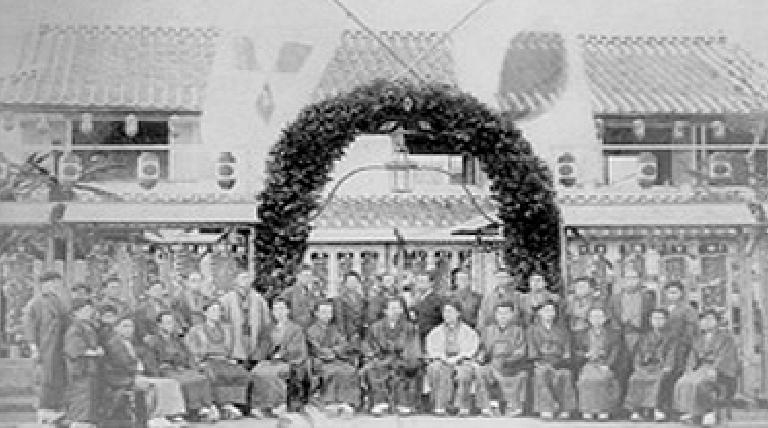Our Roots A history of rising to the challenge vol.7
Sailing Across the Globe
We focus on a period when Yataro Iwasaki made large strides towards realizing his global aspirations as Mitsubishi proceeded to establish international shipping lines.

After the Meiji Restoration, Yataro was placed in charge of operations at the Tosa Domain's Osaka residence. He was also in a position to oversee the operations of Tsukumo Shokai, a trading company established by members of the Tosa Domain. The flags flown on the company's ships resembled the crest of the Tosa Clan, but the design used diamond-shaped figures to depict the crest's three oak leaves. Yataro became a private citizen after Japan's new government abolished the feudal domains and he subsequently took up the management of Tsukumo Shokai. In 1873, he renamed the company Mitsubishi, literally "three diamonds", in reference to the diamonds on the flags of the company's ships.
Mitsubishi won the government's confidence by assisting with marine transport. Mitsubishi later established a shipping line between Yokohama and Shanghai after being entrusted with 13 government ships. On February 3, 1875, Yataro watched as the Tokyo Maru embarked on the inaugural voyage to Shanghai: "In time, we will sail across the globe to the U.S. and to Europe."
However, a protracted price war soon broke out with Pacific Mail (PM), a U.S. company which already offered services to Shanghai. Fares quickly dropped by more than 50%. Yataro appealed to Mitsubishi's employees to rise to the challenge before them. Meanwhile, the Japanese government granted a subsidy to Mitsubishi, while reserving the right to commandeer the company's ships in times of emergency. The government also awarded Mitsubishi 18 ships from a failed, government-backed shipping venture. This greatly expanded the size of Mitsubishi's fleet. The company changed its name to Mitsubishi Mail Steamship Company, with "Mail" being added in recognition of its new state functions, such as mail carrying.
Meanwhile, the battle over the Shanghai Line raged on. In an effort to ensure the continued development of Japan's maritime transport industry, the government eventually pledged financial support for the purchase of PM's Shanghai Line and Mitsubishi completed the buyout.
However, a British company named P&O moved in after PM's withdrawal. P&O established services between Osaka and Tokyo, in addition to a line linking Hong Kong, Shanghai and Yokohama. The company quickly attracted many customers. Mitsubishi began to offer financing for shippers as part of an effort to bolster its services. The company also sought to reduce expenses as Yataro and others accepted sharp cuts in their salaries. Meanwhile, the government enacted measures to slow the advance of foreign shipping companies. Eventually, P&O also decided to discontinue its Japanese lines.
In the years that followed, Yataro made steady progress in realizing his global aspirations as Mitsubishi went on to open lines serving Tianjin, Korea, Hong Kong, Vladivostok and other overseas locations.

Japan's First Bonuses?
In 1876, after Mitsubishi prevailed in the struggle over the Shanghai Line, Yataro rewarded employees by dispensing bonuses to staff at each level in the company. The amount provided was equal to approximately one month's pay. As a result, Yataro is credited with paying out Japan's first bonuses after the establishment of modern companies during the Meiji Period. The head office of Mitsubishi Mail Steamship Company circa 1877
(Photo courtesy of the Mitsubishi Archives)